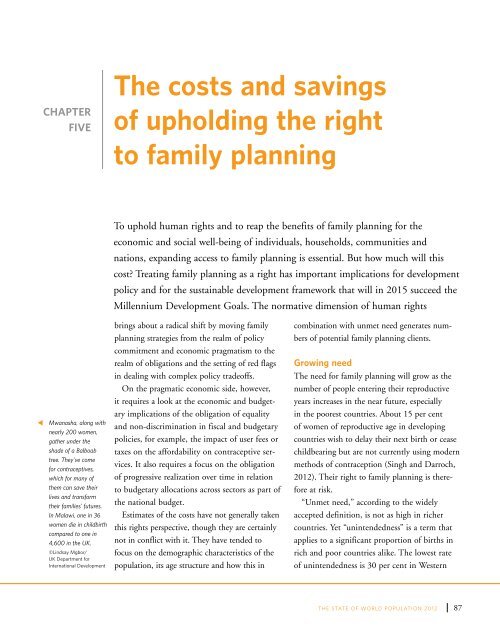State of World Population 2012 - Country Page List - UNFPA
State of World Population 2012 - Country Page List - UNFPA
State of World Population 2012 - Country Page List - UNFPA
You also want an ePaper? Increase the reach of your titles
YUMPU automatically turns print PDFs into web optimized ePapers that Google loves.
CHAPTER<br />
FIVE<br />
The costs and savings<br />
<strong>of</strong> upholding the right<br />
to family planning<br />
To uphold human rights and to reap the benefits <strong>of</strong> family planning for the<br />
economic and social well-being <strong>of</strong> individuals, households, communities and<br />
nations, expanding access to family planning is essential. But how much will this<br />
cost Treating family planning as a right has important implications for development<br />
policy and for the sustainable development framework that will in 2015 succeed the<br />
Millennium Development Goals. The normative dimension <strong>of</strong> human rights<br />
t<br />
Mwanasha, along with<br />
nearly 200 women,<br />
gather under the<br />
shade <strong>of</strong> a Balboab<br />
tree. They’ve come<br />
for contraceptives,<br />
which for many <strong>of</strong><br />
them can save their<br />
lives and transform<br />
their families' futures.<br />
In Malawi, one in 36<br />
women die in childbirth<br />
compared to one in<br />
4,600 in the UK.<br />
©Lindsay Mgbor/<br />
UK Department for<br />
International Development<br />
brings about a radical shift by moving family<br />
planning strategies from the realm <strong>of</strong> policy<br />
commitment and economic pragmatism to the<br />
realm <strong>of</strong> obligations and the setting <strong>of</strong> red flags<br />
in dealing with complex policy trade<strong>of</strong>fs.<br />
On the pragmatic economic side, however,<br />
it requires a look at the economic and budgetary<br />
implications <strong>of</strong> the obligation <strong>of</strong> equality<br />
and non-discrimination in fiscal and budgetary<br />
policies, for example, the impact <strong>of</strong> user fees or<br />
taxes on the affordability on contraceptive services.<br />
It also requires a focus on the obligation<br />
<strong>of</strong> progressive realization over time in relation<br />
to budgetary allocations across sectors as part <strong>of</strong><br />
the national budget.<br />
Estimates <strong>of</strong> the costs have not generally taken<br />
this rights perspective, though they are certainly<br />
not in conflict with it. They have tended to<br />
focus on the demographic characteristics <strong>of</strong> the<br />
population, its age structure and how this in<br />
combination with unmet need generates numbers<br />
<strong>of</strong> potential family planning clients.<br />
Growing need<br />
The need for family planning will grow as the<br />
number <strong>of</strong> people entering their reproductive<br />
years increases in the near future, especially<br />
in the poorest countries. About 15 per cent<br />
<strong>of</strong> women <strong>of</strong> reproductive age in developing<br />
countries wish to delay their next birth or cease<br />
childbearing but are not currently using modern<br />
methods <strong>of</strong> contraception (Singh and Darroch,<br />
<strong>2012</strong>). Their right to family planning is therefore<br />
at risk.<br />
“Unmet need,” according to the widely<br />
accepted definition, is not as high in richer<br />
countries. Yet “unintendedness” is a term that<br />
applies to a significant proportion <strong>of</strong> births in<br />
rich and poor countries alike. The lowest rate<br />
<strong>of</strong> unintendedness is 30 per cent in Western<br />
THE STATE OF WORLD POPULATION <strong>2012</strong><br />
87
















